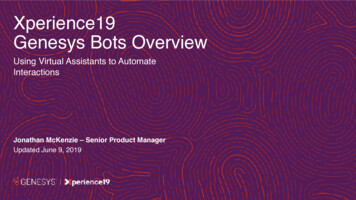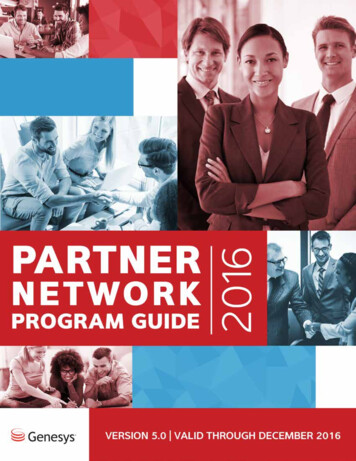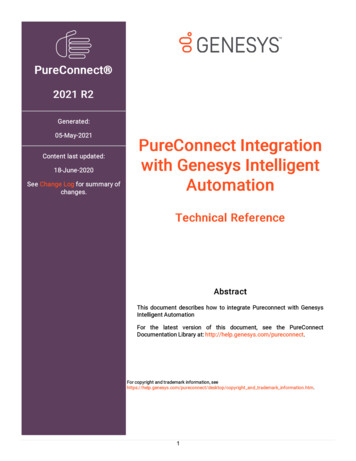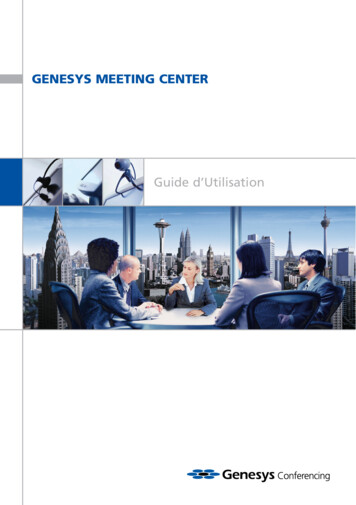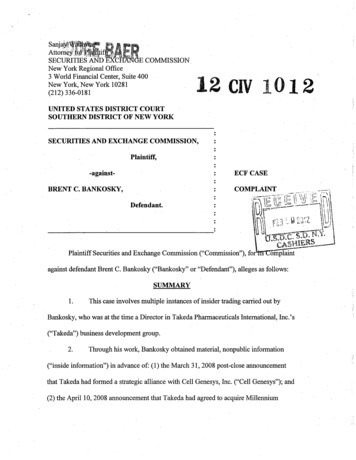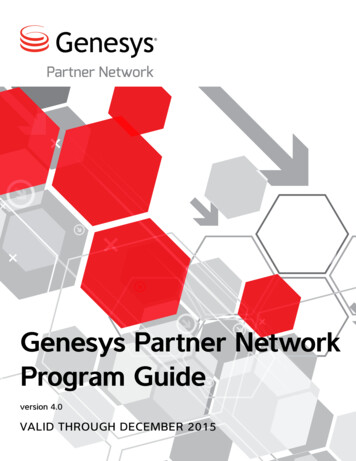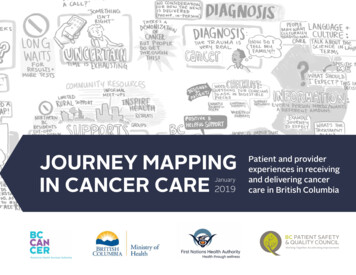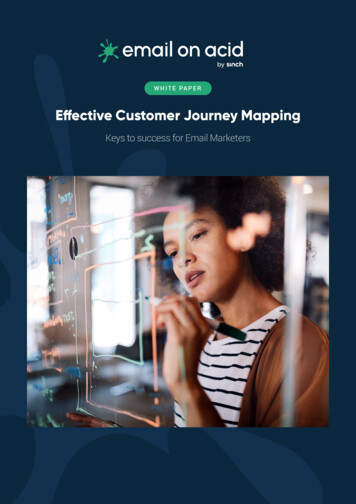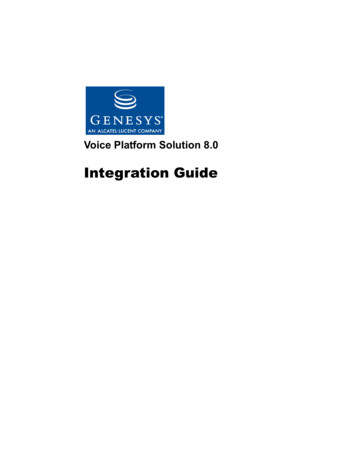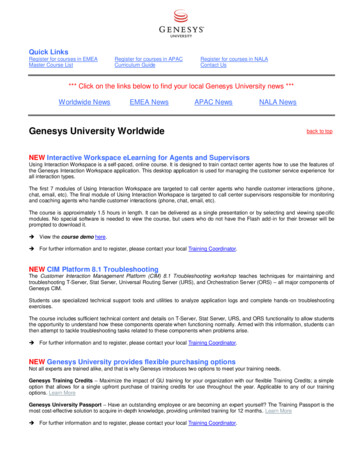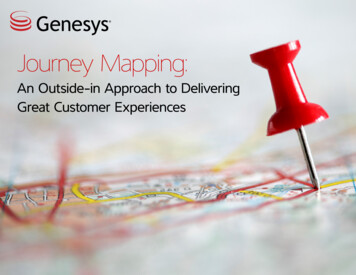
Transcription
Journey Mapping:An Outside-in Approach to DeliveringGreat Customer Experiences
1. WHAT’S A CUSTOMER JOURNEY?A customer journey is the set of interactions a customer has with your business to complete a tasksuch as evaluating, onboarding, getting support, or renewing a product or service.Taking a step back, Customer Journey Management is an omnichannel customer engagementstrategy that takes an outside-in approach from the customer’s perspective to improve customerexperience (CX) for the most important of your customer’s journeys. It’s a subset of CustomerExperience Management (CEM) which Gartner defines as “the practice of designing and reactingto customer interactions to meet or exceed customer expectations and, thus, increase customersatisfaction, loyalty and advocacy.”In practice, Journey Management typically involves breaking down traditional system, departmentand channel silos to unify and automate the customer engagement process. Cross-channelcustomer context is collected and analyzed to inform self-service and assisted service next bestactions in real time and then to support continuous optimization of the customer experience overtime.In each industry, only the subset of journeys that drive high transaction costs or high incrementalcustomer value (CX, loyalty, up-sell) really matter. These are where we focus efforts for thegreatest returns.www.genesys.comJoin the Conversation
COMPANIES THAT FOCUS ON JOURNEY OPTIMIZATIONPERFORM DRAMATICALLY BETTERWebsiteMobile AppContact CenterBack OfficeBranchPurchase JourneyOnboarding JourneyAccount Change JourneyProblem Resolution JourneyRenewal and Repurchase JourneyRevenueGrowth 10to 15%CustomerSatisfaction20%Lower Costto Serve15 to 20%Source: McKinseywww.genesys.comJoin the Conversation
2. WHY FOCUS ON CUSTOMER JOURNEYS TO GET OUTSIDE-IN?Customers are increasingly empowered by competition, digital channels and easy access to information, forcing businesses to reinvent themselves to increasecustomer value and deliver great experiences.As customers and their devices become more integrated and connected to your business and systems via the Web, self-service and mobile apps, you typicallyneed to re-factor systems and processes to consistently support customers on these new touchpoints. This digital disruption is making customer experience apriority and shifting business focus from traditional systems of record to dynamic systems of engagement.Taking a journey-focused, outside-in approach to continuous CX optimization helps put the customer at the center of your business strategy, which in turn drivesloyalty and revenue. Companies with a mature approach to customer experience take an iterative, disciplined approach to continuous improvement, with theongoing assessment and optimization of customer journeys as a core practice.www.genesys.comJoin the Conversation
3. WHAT ARE JOURNEY MAPS?The traditional focus of IT systems primarily accountsfor the information under the company’s control, butthe customer’s buying cycle starts long before theyvisit the website — and the service and supportexperience continues long after they place theirorder. Companies that fail to take the full buyingcycle into account commonly under-deliver oncustomer expectations.EVALUATEPURCHASESUPPORTSo how do you visualize the outside-in scenario to seethe full picture including customer perceptions, mobileand social media engagement? The short answer isby creating journey maps which visually documenta customer persona’s needs, perceptions and thetouchpoints encountered for each step towards thecustomer’s journey goal.Journey maps are a common approach used to designcustomer-centric processes for multi-channel customerengagement. They often serve as the foundation for CXoptimization programs, identifying new ways to helpyour customers reach their goals while still deliveringon the company’s objectives. As one of the primarydiscovery tools employed to better understand yourcustomer’s interactions with your company, thesejourney maps should be data driven and sourced bothfrom customers and direct research (e.g. mysteryshopping, customer interviews, observation, webanalytics). The ultimate purpose of the exerciseis to find flaws, weaknesses and opportunities forimprovement in the current process.www.genesys.comJourney maps are like snowflakes no twojourney maps will be the same.Join the Conversation
4. HOW DO JOURNEY MAPS IMPROVE CUSTOMER EXPERIENCE?Different parts of the organization such as marketing, sales, support and collections often only understand their portion of the user’s end-to-end journey.They naturally gravitate towards supporting their own touchpoints, which then creates organizational silos. For example, it’s not uncommon to find multipledepartments sending excessive and overlapping communications to customers.Journey maps serve as a corrective lens, providing an outside-in perspective and helping multiple teams within the organization understand the big picture fromthe customer’s perspective and create a shared understanding of the experience.They create alignment across your business and help drive customer-centric change from product teams and business unit leads to IT operations and then outto marketing, sales and service. These groups are usually hindered by poor exchange of information, bad assumptions, lack of common standards and duplicationof effort.www.genesys.comJoin the Conversation
4. CONTINUED.Journey mapping helps your organization betterunderstand the customer experience includingall the journey steps and touchpoints alongthe way to achieving their goals. By exposingthe gaps between the user’s expectations andperceptions at key steps in the journey, theyinform the ecosystem (applications, touchpoints,devices), participants (partners), process stepsand influencers (social media) that enable thecustomer journey. There is typically a complex setof relationships at play.Journey Maps are instrumental in identifyinglatent user needs and pain. Correctlyapplied, they:1Surface customer-centric insights into backoffice and customer-facing systems that informopportunities and drive business value,2Deliver the context needed to support solutionideation and the validation, prioritization, designand testing of solutions for each idea, and3Inform where to apply more effort,personalization, consistency or proactivecommunication to improve the customerexperience.www.genesys.comJoin the Conversation
5. SO WHERE TO START?WHICH JOURNEYS MATTER?How do you identify the right areas to focus on tobe strategic vs. opportunistic when deciding whichcustomer journeys to map? Some journeys will beobvious to everyone as there are known problemsand executive buy-in is easy, but you need to take astep back to identify which journeys really are mostimportant and to ensure your efforts are aligned withlong-term, strategic planning.level. This aggregate view of journeys effectivelysummarizes how your customers interact with yourcompany. From this global perspective, you can seehow all the journeys fit together, how they informthe broader experience, and how they fit into yourCX vision and strategy. This makes it much easier tosee the relative importance of each journey and howit shapes the customer experience.As a change management tool that brings a customerperspective to operations, journey maps can supporta wide range of strategic and tactical objectivesfrom transforming multi-channel experiences toidentifying and resolving specific customer painpoints. Rather than just starting with the low-hangingfruit, you need to illuminate the big picture to set thefoundation for a broader perspective. This workingframework then serves to align the team, standardizeterminology and inform the effort and benefits todrive prioritization.You can next start to apply prioritization criteriaand review early metrics to identify which journeysmatter most to your customers and present thegreatest opportunity to reduce pain and createdelight. When evaluating where to start, workto factor in the goals of your organization as wellas cost, revenue, retention, brand reinforcement,customer satisfaction or other KPI-based benefitdrivers as weighted selection criteria. Creating aweighted matrix for prioritization has the additionalbenefit of providing transparency and alignmentacross the organization to focus on common goals.Scoring opportunities by effort and value is anotherclear route to prioritization.To create this framework and level the playing field,first identify all your customer journeys at a highwww.genesys.comJoin the Conversation
6. THE GENESYS APPROACH TO CX RCHFOCUSDesignREResearchEXVisionOnce it’s clear where to focus, you can commence the research and discovery to inform the CX designprocess. The Genesys Wow Method requirements discovery is based on the “Double Diamond” designprocess for products and services (Design Council, UK), comprised of four phases: discover – define –develop – deliver. This approach utilizes service design thinking tools, techniques and templates that havebeen developed and rigorously tested with leading organizations around the world.www.genesys.comJoin the Conversation
6. CONTINUED.1Vision - It starts with a Wow vision eventto clarify business priorities and high levelopportunities to deliver a “wow” experience.2Research - Next, the research starts with aCX Safari (observation, contextual interviews,ethnography, mystery shopping) andpersona identification to build the customerjourney map. Additionally, stakeholder mapsand interviews are conducted to gather theorganization’s perspective on CX. The crossfunctional design team drives the customerjourney mapping exercises to discover latentuser needs and define solutions from theperspective of the targeted user. The researchphase also identifies business challenges,customer value and brand values as context forsolution creation and to help the organizationdeliver on its brand promise.3Design - In the design phase, we focuson the challenges identified to design,prototype and test multiple solutions for anoptimized journey factoring in company goals,business requirements, cost to implement andvalue created.4Proposal - With design complete, we makerecommendations for the most appropriatenext steps for the organization.www.genesys.comJoin the Conversation
7. CREATING ACTIONABLE NEXTSTEPS FROM JOURNEY INSIGHTSwww.genesys.comObviously, journey maps inform problems butdon’t solve them. Once you’ve created visibility,the next step is to make it actionable to improvecustomer experience. The low-hanging fruitis often to seek opportunities to make specificimprovements to the current journey such asremoving unnecessary or redundant steps andthen improving inefficient steps. These typicallytarget the most painful problems uncoveredby the journey mapping exercise. Focusingon these targeted solutions then drives thevalue that justifies more structural journeyoptimization work.customer context in the form of transactions,preferences, needs and opportunities for eachstage of the journey. Leverage business rules and orchestration tobe proactive and reduce customer effort,Many additional opportunities can be addressedthrough automated, proactive customerengagement practices. For customer-centric,outside-in processes, the first step is oftenensuring you can identify customers consistentlyfor important interactions. This creates thevisibility necessary to roll up and preserve Leverage real-time analysis to determinenext best actions and shape the customer’sexperience at each moment of opportunity, Use analytics against outcomes to measureresults and drive insights for improvementvia closed loop optimization.Once we can recognize and map the customer’sjourney across touchpoints and preserve contextfor the interactions, we’re now in an actionableposition to assess each customer journey incontext of the opportunity to improve service.We can:Join the Conversation
1. COLLECT2. ENGAGE3. OPTIMIZEIdentify customer andinteractions across channelsAnalyze in real time to understandcustomer behavior, intent, engagementprofile, opportunities, etc.Drive Personalized and Proactive Engagementbased on Customer Context, Business Rulesand Predictive Next Best ActionsWebsiteActionable Insights & NextBest Action OfficeROUTING &ORCHESTRATIONInboundCustomer Engagement alBack Office SystemsOutbound Communicationwww.genesys.comJoin the Conversation
8. APPLYING JOURNEY MAPPING TO YOUR ORGANIZATIONGenesys can conduct a detailed discovery of your requirements using the Genesys Wow Method. This new way of assessingCustomer Experience visualizes the current customer journeys and identifies the root cause of current pain points. As the CustomerExperience leader with more than 10,000 customers, Genesys brings tested and proven CX Design methodologies to the table.High level examples of journey optimization applied include: Tiered Service – Offer different routing strategies and service levelsbased on segmentation, projected lifetime value, profitability, currentsatisfaction, churn risk or other factors. This maximizes value for thecustomer and the company (matching the expense to the reward).Omnichannel Context - Know when a customer is active on anotherchannel and leveraging that context. Personalization - Personalize service via a customer profile to reduceeffort on repeat transactions or target recommended offers. Effort Tracking - Track customer effort in real time and escalate toimprove CX. Proactive Communication - Add proactive notifications to keepcustomers informed.Interceptors - Optimize handling for frequent contacts to get toprevious agent or best agent.www.genesys.comJoin the Conversation
TAKE YOUR CUSTOMER EXPERIENCETO THE NEXT LEVELOrchestrate seamless, omnichannel customer journeys from a single, all-in-one, customer experience platform. Available both on-premiseand in the cloud, the Genesys Customer Experience Platform simplifies administration, increases operational performance, and reducestotal cost of ownership.Get Startedwww.genesys.comRequest a DemoLearn MoreJoin the Conversation
Website: www.genesys.comContact Us: 1-888-GENESYSGenesys, the world’s #1 Customer Experience Platform, empowers companies to createexceptional omnichannel experiences, journeys and relationships. For over 25 years, wehave put the customer at the centre of all we do, and we passionately believe that greatcustomer engagement drives great business outcomes. Genesys is trusted by over 4,700customers in 120 countries, to orchestrate over 25 billion contact centre interactions peryear in the cloud and on premises.Copyright 2017 Genesys. 2001 JuniperoSerra Blvd., Daly City, CA 94014All Rights reserved. Genesys and theGenesys logo are registered trademarksof Genesys. All other company names andlogos may be registered trademarks ortrademarks of their respective companies.
persona identification to build the customer journey map. Additionally, stakeholder maps and interviews are conducted to gather the organization's perspective on CX. The cross-functional design team drives the customer journey mapping exercises to discover latent user needs and define solutions from the perspective of the targeted user.
